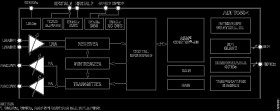High Performance, Sub GHz Radio Transceiver IC
Analog Devices
 RSS
Sample
RSS
Sample
- Darmowa próbka
- MPN:
- ADF7030-1
- Producent:
- ANALOG DEVICES
- Dodany do bazy:
- Ostatnio widziany:
Sugerowane produkty dla en13757
The ADF7030-1 is a fully integrated, radio transceiver achieving high performance at very low power. The ADF7030-1 is ideally suited for applications that require long range, network robustness, and long battery life. It is suitable for applications that operate in the ISM, SRD, and licensed frequency bands at 169.4 MHz to 169.6 MHz, 426 MHz to 470 MHz, and 863 MHz to 960 MHz. It provides extensive support for standards-based protocols like IEEE802.15.4g while also providing flexibility to support a wide range of proprietary protocols.
The highly configurable low intermediate frequency (IF) receiver supports a large range of receiver channel bandwidths from 2.6 kHz to 406 kHz. This range of receiver channel bandwidths allows the ADF7030-1 to support ultranarrow-band, narrow-band, and wideband channel spacing.
The ADF7030-1 features two independent PAs supporting output power ranges of −20 dBm to +13 dBm and −20 dBm to +17 dBm. The PAs support ultrafine adjustment of the power with a step resolution of 0.1 dB. The PA output power is exceptionally robust over temperature and voltage. The PAs have an automatic power ramp control to limit spectral splatter to meet regulatory standards.
The ADF7030-1 features an on-chip ARM® Cortex®-M0 processor that performs radio control, radio calibration, and packet management. Cortex-M0 eases the processing burden of the host processor because the ADF7030-1 integrates the lower layers of a typical communication protocol stack. This internal processor also permits the download and execution of Analog Devices, Inc., provided firmware modules that can extend the functionality of the ADF7030-1.
The ADF7030-1 has two packet modes: generic packet mode and IEEE802.15.4g mode. In generic packet mode, the packet format is highly flexible and fully programmable, thereby ensuring its compatibility with proprietary packet formats. In IEEE802.15.4g packet mode, the packet format conforms to the IEEE802.15.4g standard. FEC, as per the IEEE802.15.4g standard, is also supported.
The ADF7030-1 operates with a power supply range of 2.2 V to 3.6 V and has very low power consumption in both Tx and Rx modes, enabling long lifetimes in battery-operated systems. An ultralow power deep sleep mode achieves a typical current of 10 nA with the configuration memory retained.
A complete wireless solution can be built using a small number of external discrete components and a host processor (typically a microcontroller). The host processor can configure the ADF7030-1 using a simple command-based protocol over a standard 4-wire SPI interface. A single-byte command transitions the radio between states or performs a radio function.
The ADF7030-1 is available in two package types: a 6 mm × 6 mm, 40-lead LFCSP and a 7 mm × 7 mm, 48-lead LQFP. Both package types use NiPdAu plating to mitigate against silver migration in high humidity applications. The ADF7030-1 operating temperature range is −40°C to +85°C.
For Figure 13 to Figure 19, Figure 30, Figure 42, Figure 60, Figure 61, and Figure 75 in the Typical Performance Characteristics section, PACOARSE is a programmable value that provides a coarse adjustment of the PA output power. This value can be programmed in the range of 1 to 6 for PA1, and from 1 to 10 for PA2. PAFINE is a programmable value that provides a fine adjustment of the PA output power. This value can be programmed in the range of 3 to 127 for both PA1 and PA2. PAMICRO is a programmable value that provides a microadjustment (typically <0.1 dB) of the PA output power. This value can be programmed in the range of 1 to 31 for both PA1 and PA2. PAOLDOVOUTCON is a programmable value that configures the internal LDO voltage that provides bias for the PA. For additional information on these bit settings, see the ADF7030-1 Software Reference Manual, which is the detailed programming guide for the device.
Applications
* IEEE 802.15.4g (MR-FSK PHY)
* Wireless M-Bus (EN 13757-4)
* Smart metering
* Security and building automation
* Active tag asset tracking
* Industrial control
* Wireless sensor networks (WSNs)
* Radio frequency (RF) ranges
* 169.4 MHz to 169.6 MHz
* 426 MHz to 470 MHz
* 863 MHz to 960 MHz
* Data rates
* 2FSK/2GFSK: 0.1 kbps to 300 kbps
* 4FSK/4GFSK: 1 kbps to 360 kbps (transmit only)
* Dual power amplifiers (PAs)
* Programmable receiver channel bandwidth from 2.6 kHz to 406 kHz
* Receiver (Rx) performance
* Up to 97 dB blocking at ±20 MHz offset
* Up to 72 dB adjacent channel rejection
* −134.3 dBm sensitivity at 0.1 kbps
* −121.3 dBm sensitivity at 2.4 kbps
* Transmitter (Tx) performance
* −20 dBm to +17 dBm range with 0.1 dB step resolution
* Very low output power variation vs. temperature and supply
* Low active current
* 50 mA Tx current at 17 dBm
* 21.2 mA Rx current at12.5 kbps
* Ultralow sleep current
* 10 nA with memory retained
Elecena nie prowadzi sprzedaży elementów elektronicznych, ani w niej nie pośredniczy.
Produkt pochodzi z oferty sklepu Analog Devices